Contents
Recently, more and more often columnar apple trees or columnar pears began to appear in summer cottages – strange trees, more like lonely branches strewn with fruits. Their appearance is charming, but they are attractive not only for their unusualness – plantings of columnar apple and pear trees are easier to care for, they need less space in the garden. If you choose the right variety, then you can grow them both in the suburbs and in Siberia.
Features of columnar apple trees
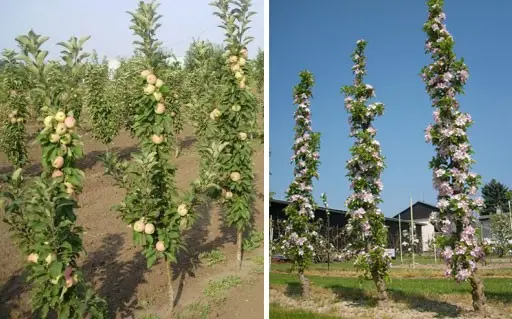 Columnar apple trees appeared, and then pears, relatively recently, one might say, almost by accident. In 1964, an interesting mutation was noticed in Canada – a branch grew on a fifty-year-old apple tree of the Macintosh variety, on which the fruits were located in an unusual way. Breeders managed to create a variety “Vazhak” with the same properties – the fruits grew on the trunk itself and on very short fruit twigs. And after that, already in the 80s, several varieties of apple trees were created, and then pears, which, by their external similarity, were called columnar. Original in appearance, compact and productive, they quickly interested breeders – the result today is a large selection of varieties of dwarf, semi-dwarf and tall trees.
Columnar apple trees appeared, and then pears, relatively recently, one might say, almost by accident. In 1964, an interesting mutation was noticed in Canada – a branch grew on a fifty-year-old apple tree of the Macintosh variety, on which the fruits were located in an unusual way. Breeders managed to create a variety “Vazhak” with the same properties – the fruits grew on the trunk itself and on very short fruit twigs. And after that, already in the 80s, several varieties of apple trees were created, and then pears, which, by their external similarity, were called columnar. Original in appearance, compact and productive, they quickly interested breeders – the result today is a large selection of varieties of dwarf, semi-dwarf and tall trees.
Columnar trees grow up to a maximum of 2,5 meters in height, and a width of 30 to 50 centimeters. Each tree is a single trunk, from which short fruitful branches grow at an acute angle. If you do not cut the crown, then the tree will resemble a pyramidal poplar. Compact roots allow for very dense plantings, it is easy to harvest from closely growing apple and pear trees, and it is convenient to care for them (foliar top dressing, therapeutic spraying). If the owner manages to create the necessary conditions and properly organize good care, then from each tree, depending on the variety, you can get from 6 to 12 kg of fruit.
The main disadvantage of columnar apple trees and pears is considered to be a not too long fruiting period. If you plant a tree in the spring, then after a good rooting, it can immediately bloom and even bear fruit (but experts advise removing the flowers of the first year). Until the seventh or eighth year, the number of fruits with good care will only increase, and then it will begin to gradually decrease. Although most varieties bear fruit for at least 15 years, the number of fruits in the eighth and fifteenth year is very different. So it turns out that having bought expensive seedlings, after 10 years or a little more, the owner must change the tree.
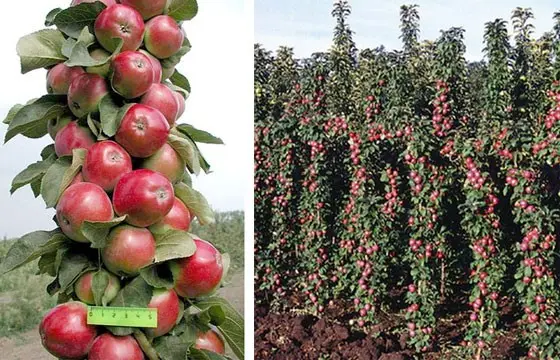
Until recently, these unusual trees, if they appeared in private gardens, then performed a more decorative function. Not too large root system allows you to grow them not only in open ground, but even in large flowerpots that can be moved from place to place, given the design requirements. But it seems that these graceful trees, hung with fruits, still found their way to the hearts of summer residents.
Which grade to choose
It is best to buy seedlings of columnar apple and pear trees in special nurseries, because on the market you can take ordinary varieties that are grafted onto dwarf rootstocks and form a similar crown shape. The most popular early varieties that ripen in the summer are “President”, “Amber Necklace” and “Medoc”. Among the most late-ripening ones, Arbat, Moscow Necklace, Currency, Bolero can be noted. Of the mid-season, Titania, Vasyugan, and Gin are usually grown. There are no big differences in care.
“President” and “Medok” are semi-dwarf varieties, the trees do not grow above 2 meters, the fruits ripen in late summer or autumn.
These are frost-resistant varieties, they survive the winter without losses with forty-degree frosts, they grow in Western Siberia. The compact root system tolerates transplants well. The fruits of both varieties are large – 200 – 250 g, only “Medka” is very sweet, and “President” – with sourness. They can also be distinguished by color – apples of the “President” variety are somewhat cast in yellowness, and not richly yellow, like in the “Medok” variety.
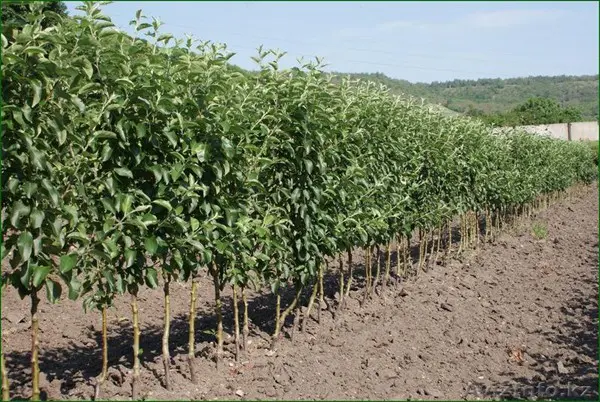
Juicy crisp apples of the Amber Necklace variety are not at all amber in color, they are rather golden, with a blush and a greenish barrel. Medium-sized fruits (up to 170 g) ripen in autumn, usually until mid-September. “Amber Necklace” is considered a frost-resistant variety, but the top of the tree can freeze in winter, it is better to cover it. If you plant a tree in the spring, it will bloom immediately after rooting, you can let it bear fruit, but experts advise strongly thinning the ovaries.
The autumn variety “Vasyugan” grows up to 3 m, bears fruit immediately after planting, with good care gives up to 10 kg of fragrant sweet and sour apples. Its elongated red-green fruits usually reach 200 g and ripen by mid-September. “Vasyugan” easily tolerates forty-degree frosts, is resistant to diseases and pests, and can grow in Siberia.
Very popular among gardeners (not only in the Moscow region) is the winter variety “Moscow Necklace”. Its fruits are usually less than 190 g, round, red, with dense skin and juicy pulp, they have a pleasant aroma and a sweet taste with a slight sourness, ripen in mid-October. “Moscow Necklace” easily tolerates frosts, practically does not get sick, but has one feature – it is a self-fertile variety. “Moscow Necklace” will not be able to bear fruit if apple trees of other varieties do not grow nearby.

Dwarf “Currency” is also considered a winter variety, gives up to 12 kg of apples from one tree, and begins to bear fruit immediately after rooting. The fruits of “Currency” are round-flat, red with a golden blush, thin-skinned, sweet dessert taste. Caring for “Currency” does without chemicals, because the trees practically do not get sick, this is not the most frost-resistant variety, but it ripens well in the middle lane. It can be a good neighbor for the Moscow Necklace.
It is difficult to choose from varieties when they all give such delicious beautiful fruits, but you need to pay attention not so much to the taste of fruits as to the ability to grow and bear fruit without special care in the right area.
When is the best time to plant
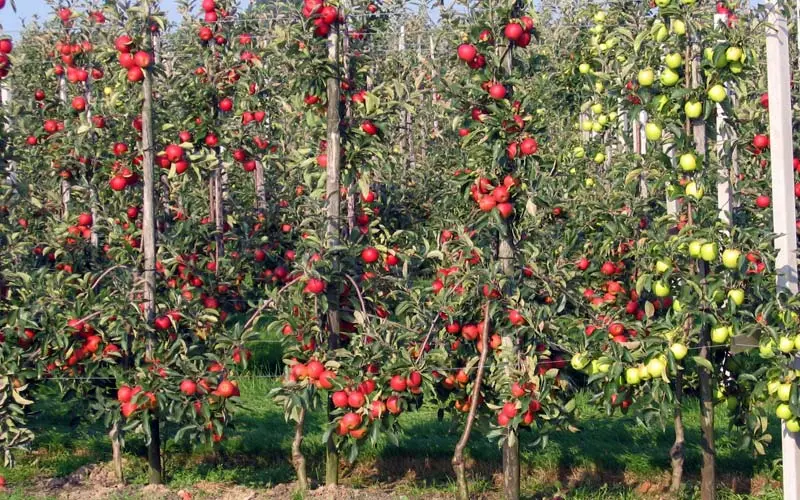
Columnar apple and pear trees are planted, like all other trees – in spring or autumn. In the spring, this is done before bud break, approximately after mid-April (the date depends on the time of arrival of heat), and in the fall – towards the end of September, while it is still warm, and the tree can take root before frost. Some experts say that it will be right to plant in the spring – then the tree will definitely take root and will not suffer from the cold. Others argue that after planting in the fall, the fruiting of the first year will not harm the tree.
Be that as it may, both options give good results, so each owner chooses simply more convenient for him.
How to plant
Columnar trees are rarely planted one at a time, and for large plantings, they usually prefer dense, that is, they place the trees close to each other. Most often they are planted in rows along paths or fences, so 40 or 50 cm are left between trees in a row, and 1 meter between rows. With such a dense planting, these small but very productive trees quickly deplete the soil, which is why it is well fertilized in advance.
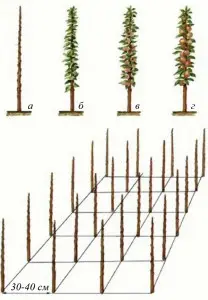
If only one tree is planted, then a hole is prepared for it in advance: for spring planting – in the fall, and for autumn planting – in the spring. It is enough to dig a cube with a side of 50 cm, place compost or humus (4 kg) on the bottom, 2 tablespoons of superphosphate and potassium each. If the soil is acidic, then it is worth adding 50 g of dolomite flour. The pit and the excavated earth must be covered so that the rains do not wash away, leave it like that until the moment of landing.
Before planting, you need to inspect the seedling well (it would be correct to take an annual one) – its trunk should be devoid of leaves, and the roots should be wet. If the roots are dry, then they are dipped in warm water for 10 hours, the wrinkled bark at the top near the kidney also testifies to drying out, then a warm bath for the roots will also help. You can even cut off a little secondary roots so that they absorb moisture more quickly.
The pit probably crumbled, which means that it is necessary to restore its original shape, mix the compost inside, take out part of it, then place the seedling so that the roots are straightened, fill in the compost and earth. If the tree is planted correctly, then its root neck rises 5 cm above ground level. Each tree must be watered with a couple of buckets of water, then the soil around it should be mulched. Usually, a trellis is driven in near young seedlings and the tree is tied very carefully, without damaging the bark and twigs.
Since trees love water, but do not tolerate its stagnation, in a lowland it is better to make a good drainage layer at the bottom of the pit. It is better not to plant them where groundwater is close.
Video “Planting columnar apple trees”
This video will show you how to properly plant columnar apple trees.









